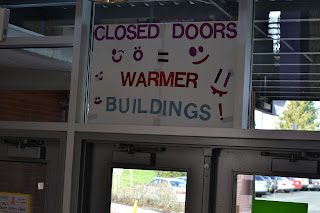By interest, Hartford is more the artist and ballet type. Her first environmental classroom project was raising salmons from eggs. Caring for and nurturing them brought out what she calls "the naturalist in me."
 |
| Marie Hartford showing the props used in a recent energy saving skit recording. |
Keeping the conditions right for raising the salmon was tricky at times, especially keeping the pH just right. At one point, it involved kids hauling 5 gallon buckets of pond water (located at corner of school property) and mixing it with a certain ratio of tap water to obtain the proper pH.
Hartford's current classroom of students is raising frogs. She said "This type of frog, red legged frog, is native to this area." Currently she is working with the district and city to seek permission to introduce the frogs to the school's pond. If this is approved, it would be timed perfectly with certifying the school as a wildlife friendly site.
 |
| Hartford showing Redmond Wild's co-Leader Nithi, the frog eggs. |
Who would create the right habitat for the frogs and wildlife around the school?
The design and implementation of habitat will be a collaborative effort
between the Elementary students and Redmond High students.
This is not the first Sustainable Project that Harford has spearheaded at Horace Mann. Her green teams have successfully implemented and are working on the following projects:
- Reusuable Cafeteria Trays - One of the first Green Team's projects. It started when Hartford asked the cooks to save the trash for one week, then had it laid out on a tarp for the kids to see. She asked them, "What do you notice." They noticed there was a lot of styrofoam in there. She then gave them some facts about styrofoam. All of a sudden, the kids were taking ownership in the problem and offering to clean the trays themselves if they could go to reusable trays. She said it is good for kids to be involved in this type of work, what she calls "authentic work." The switch to reusable trays has spread out through the entire LWSD now.
- No Idling zone - Kids tabulated how many car's were idling and for how long. The school now has a "no idling zone" in effect for student drop-off. Recently HM students went in front of City of Redmond's transportation department with the result, "The City of Redmond would consider a no idling ordinance for the city" said Hartford. The cities transportation department has also offered free transportation for students to present their "no idling zone" story to other schools.
- Walking School Bus - Parents take the role of Captain or co-Captain and lead a group of students, walking, to school. See Jeanne Gustafson's earlier article for more info. The 4th grade green team students just met this last week to plan HM's next Walking School Bus day.
- Energy Conservation - The kids made signs signaling where energy could be saved. They switched some of the classroom lights to energy efficient lighting. The hallway lights now have every other light on now.
- Wildlife Friendly Habitat - As mentioned above, the school is currently certifying to be a Wildlife friendly schoolyard. By providing Food, Water, Cover, Places to Raise Young and Sustainable Practices schools, businesses and homes can certify as a Wildlife Habitat. See Redmond Wild's recent article for more info.
- Parnership and sharing ideas with other Schools - Initiated by HM students, a partnership with Redmond High school has grown and will soon include the pond restoration. HM students have recently initiated with Redmond Junior high for collaboration in future projects. There has also become a sharing of ideas between schools including: Einstein Elementary in Redmond and Mark Twain, Juanita Elementary in Kirkland to name some of them.
- Other programs - Such as reuse, recycling and having a worm bin on site.
Seeing these great programs in effect left me wondering how can these types of sustainable measures, measures that are strong in community effort, be transferred to other schools, so I asked the following question. For teacher's, parents and students who wish to start these or similar programs at their school's, what is your "secret sauce" to make it happen?
Hartford's response can be summed up in 4 steps.
Hartford's response can be summed up in 4 steps.
- Get to know your community and what their interest/needs are. For HM, it came from an observation by the kids that the outdoor were smelly on rainy days due to more parents dropping kids off and the extra exhaust smoke. Since they had many cases of Asthma, this became an important project health-wise as well.
- Get Parent and PTSA support.
- Be patient and positive with the school principle.
- Work with the departments. For her that has been LWSD facilities. The Resource Conservation Manager Program Lead, Chuck Collins, was able to find HM a planting grant if they were able to cut the energy by 5% during a few month time period.
Stay tuned for these future sustainable article topics: spotlighting a Bellevue business, Redmond Wild's Certification Program as they close-in to their goal of certifying the entire City of Redmond (they only need a few more homes to certify to make it happen!) as a Community Wildlife Habitat and a district-wide look at schools on the Eastside!
Until then, as Hartford would say "Thank you for your hard work. We are moving forward with higher energy efficiency, lower emissions and a greener school yard [Eastside Community!] all because of you."








Mrs. Hartford was and forever will be my favorite teacher in the world
ReplyDelete